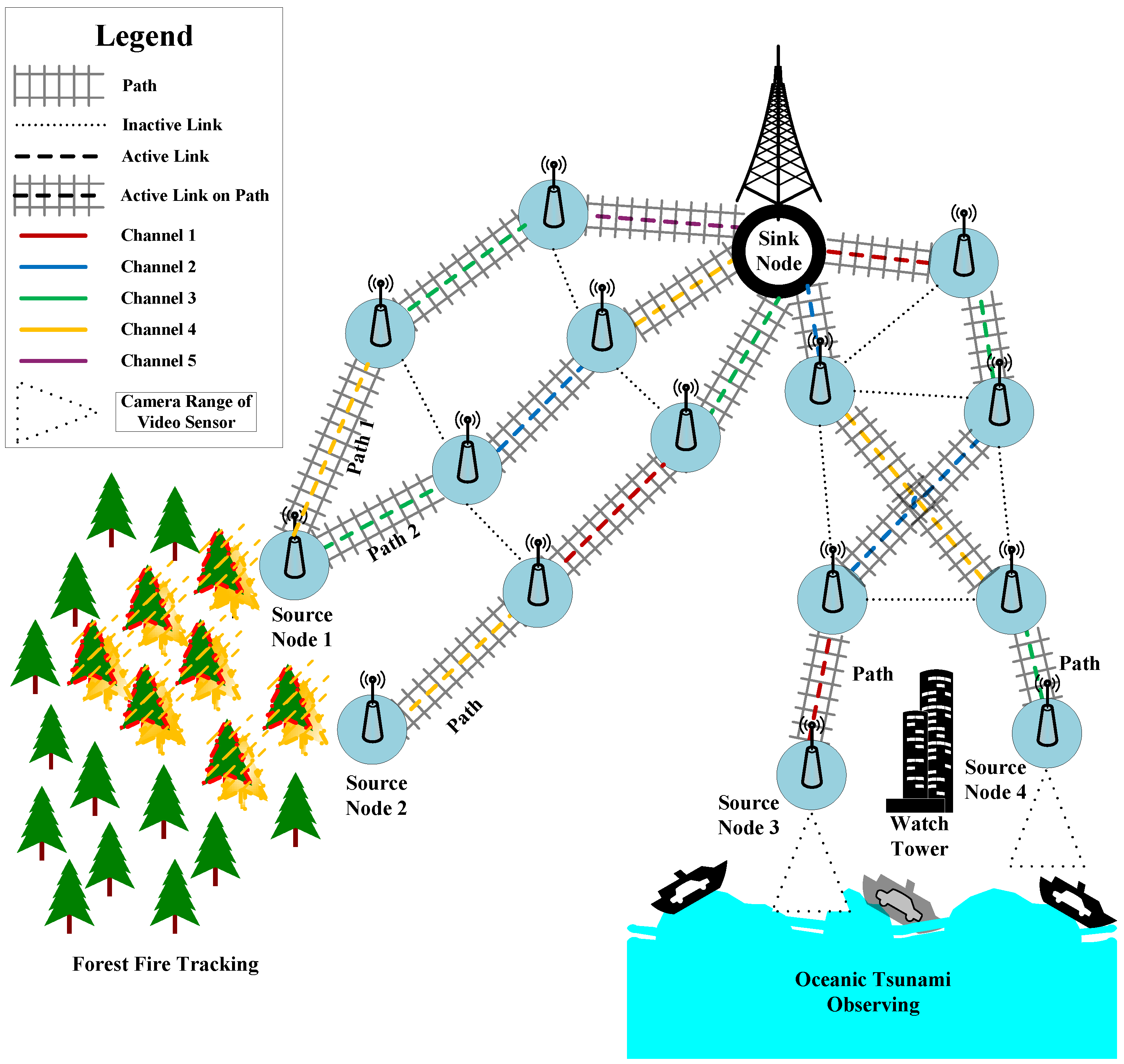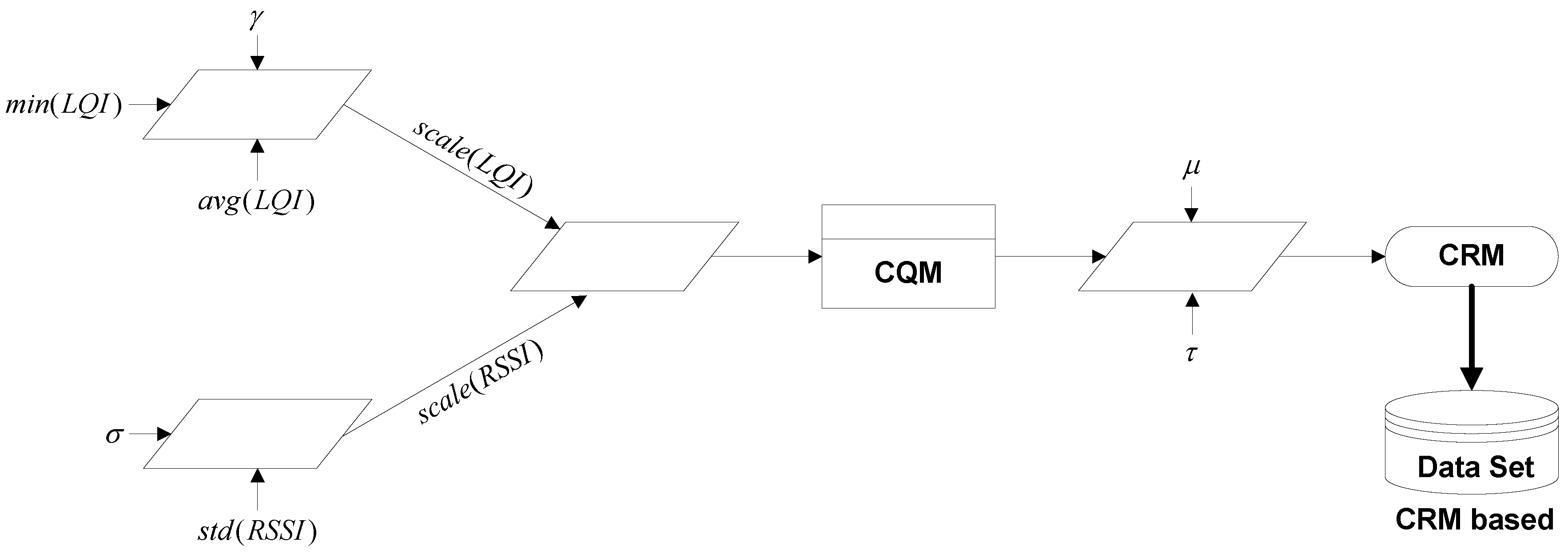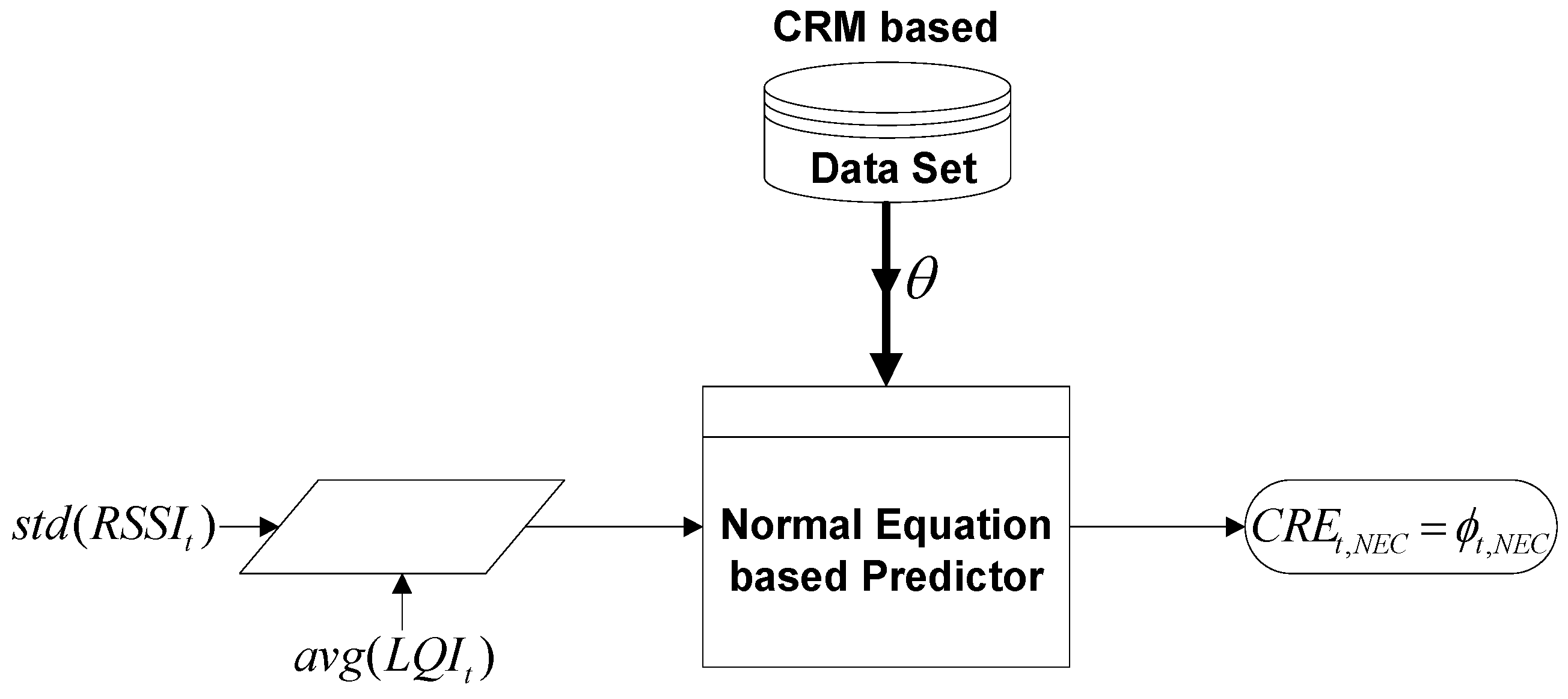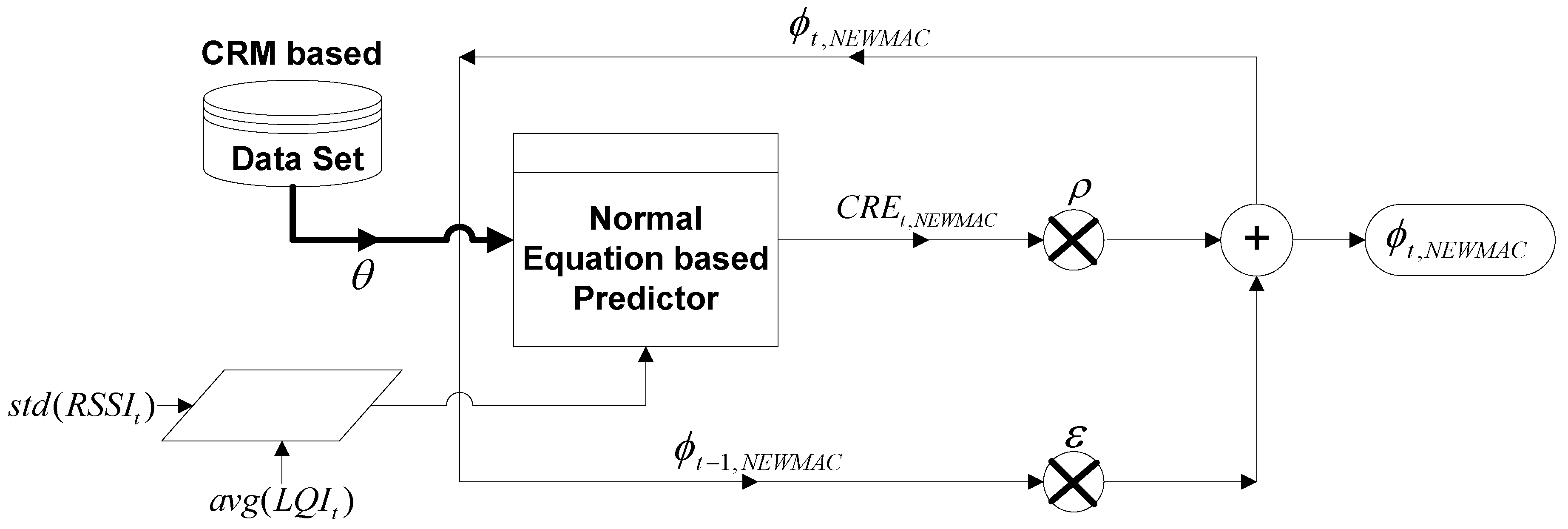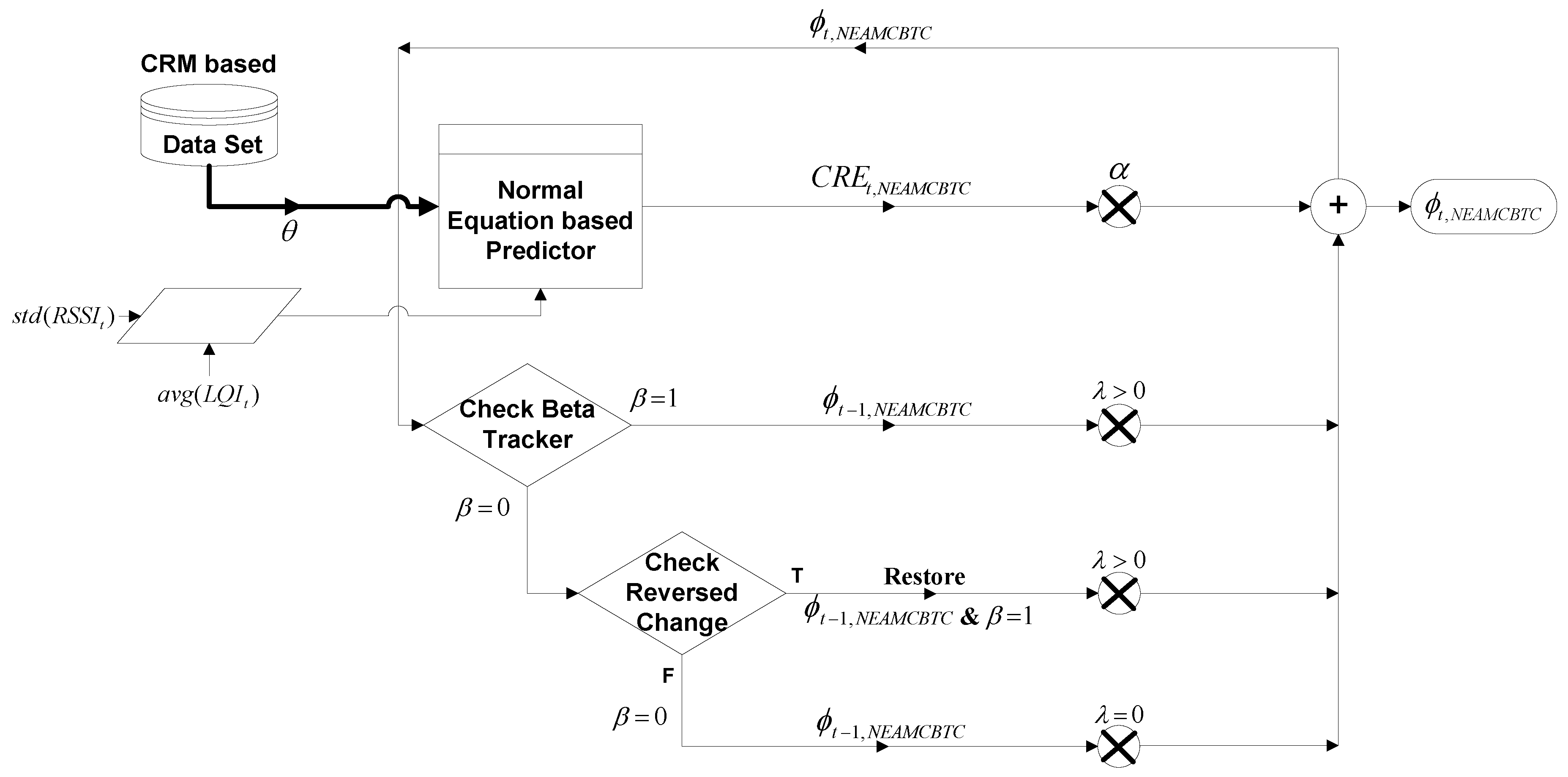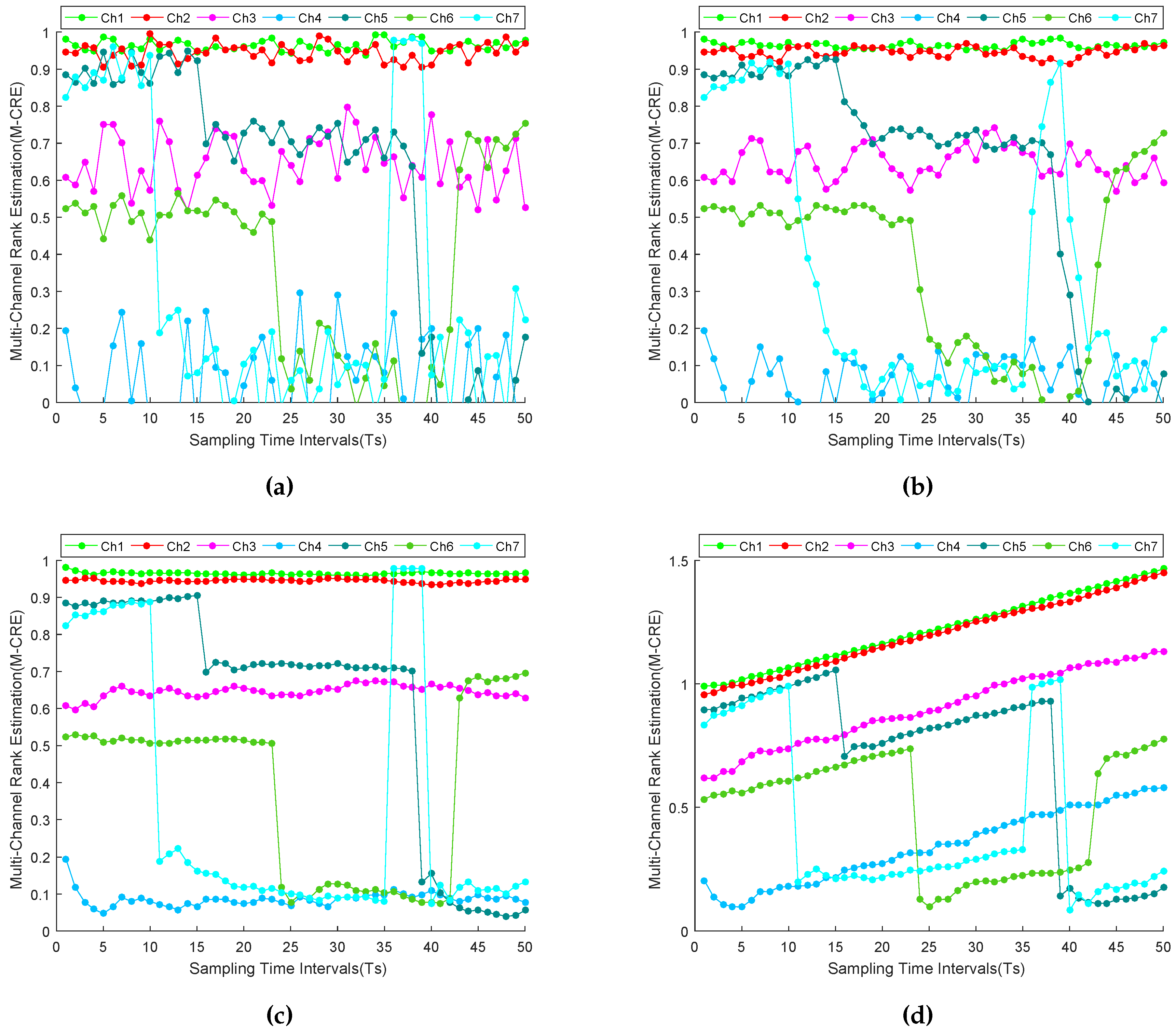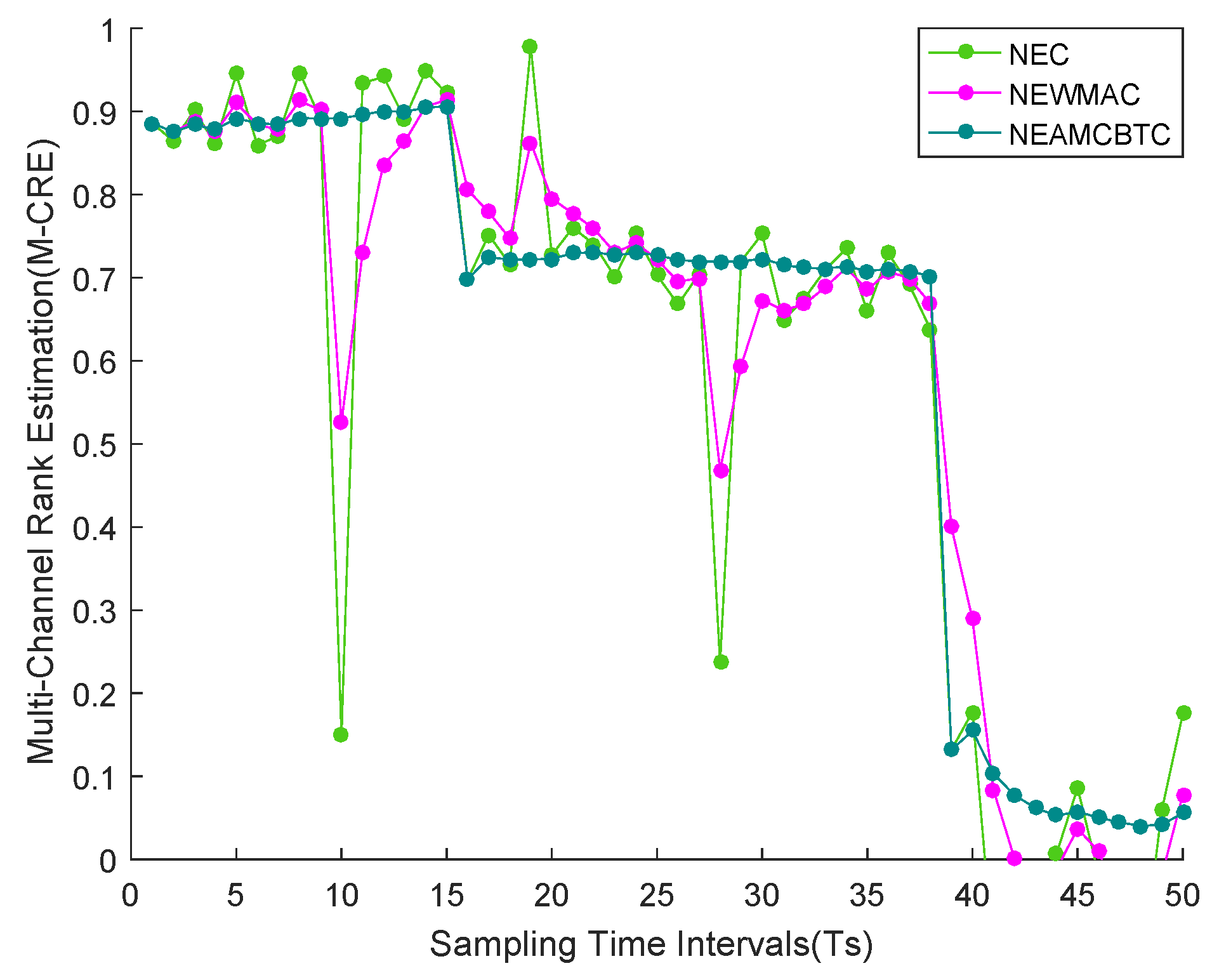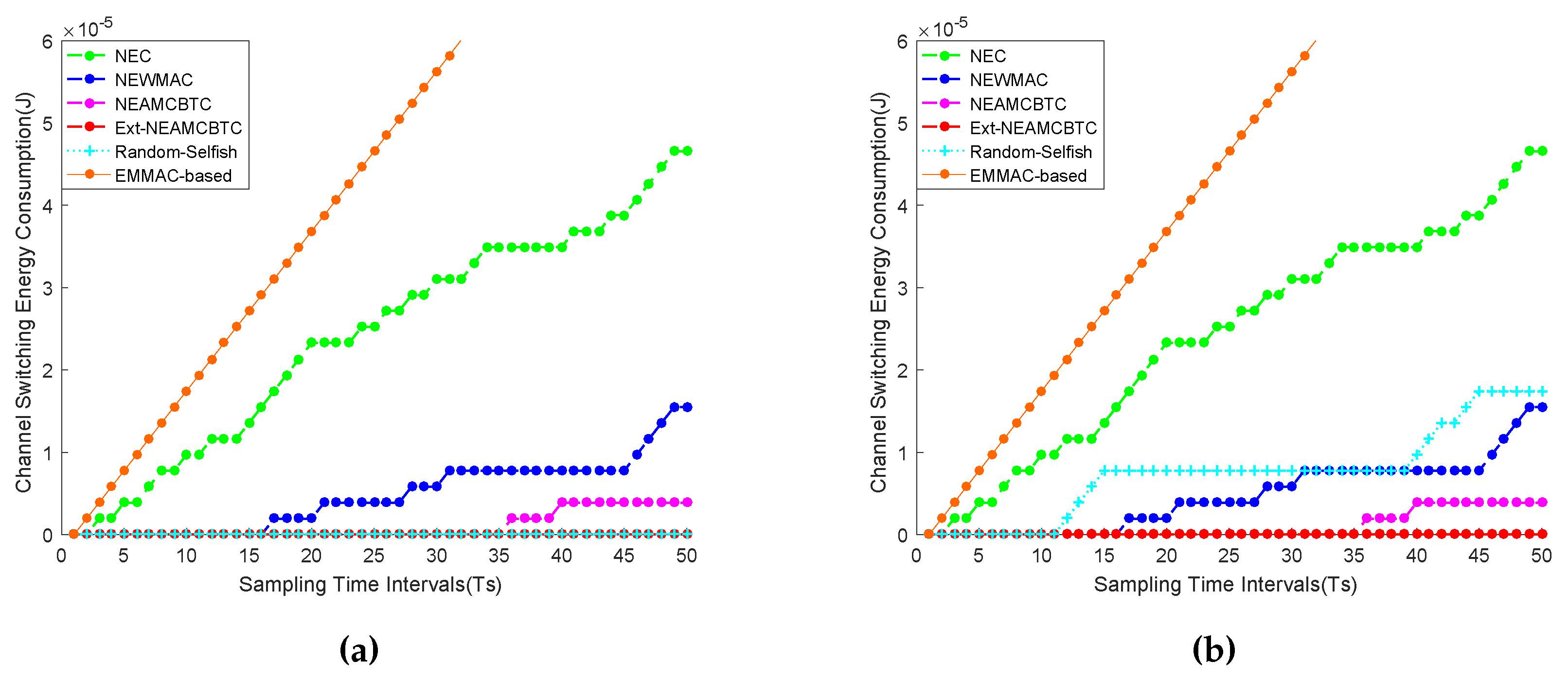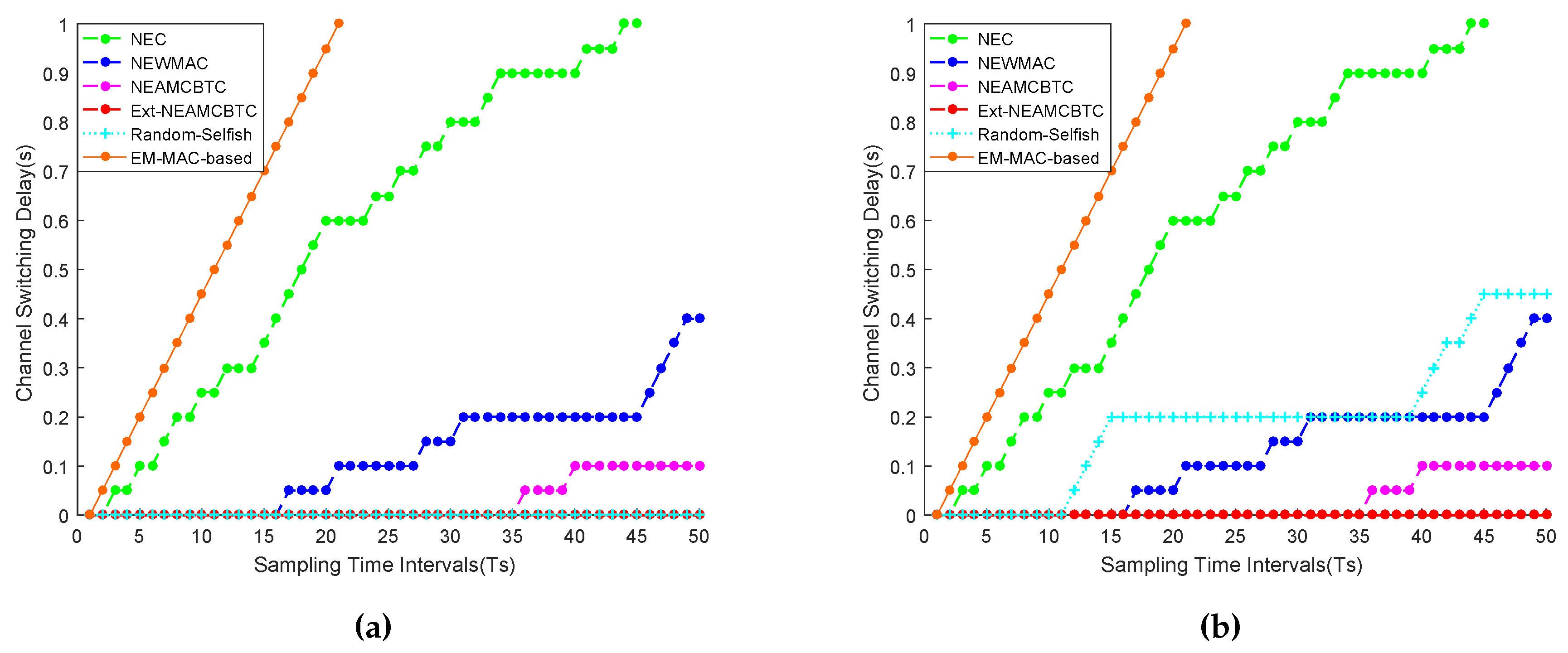1. Introduction
Wireless sensor networks (WSNs) consist of tiny devices, which have limited energy, memory, sensing/processing unit and transmission capability [
1]. Such networks often also have the capacity of self-organization in ad hoc mode [
2,
3]. Traditionally, energy efficiency has always been a key issue in WSNs, whereas throughput, fairness and delay were not so much the focus of research [
4]. However, technological advancement has shifted this focus and enabled sensor nodes to transmit large volumes of scalar environmental data, e.g., concerning temperature, humidity or pressure. Meanwhile, camera and microphone-enabled sensor nodes have emerged; networks build from such nodes are called wireless multimedia sensor networks (WMSNs) [
5,
6] and have the ability to transmit very large volumes of delay-sensitive multimedia data to sink nodes. Additionally, a variety of multipath and multichannel approaches have been proposed by researchers whose purpose is to further improve the performance of WSNs.
Figure 1 shows a sample scenario using multiple paths and channels. Source Node 1 and the sink node are connected by two paths, whereas the remaining sources can communicate with the sink using only a single path. Any two neighbor nodes on a path have an active link between them, which resides on the best among all available channels.
Unlike sensor nodes in conventional networks, nodes in multichannel sensor networks additionally have to deal with a potentially large number of channels for data routing, i.e., they have to decide which channel to use for transmission; the better the choice the better the overall system performance. Therefore, an appropriate channel quality/stability assessment is needed. Since the behavior of wireless channels is probabilistic in nature (which makes channel quality assessment a recurrent task), any instantaneous channel quality assessment cannot, by nature, provide an adequate measure of the channels’ health. In [
7], the authors have realized that combining current and past channel quality assessments at the receiver may help to predict the channel quality indicator (CQI), which may guide the transmitter to adapt the transmission parameters accordingly and improve the performance of the wireless communication systems.
A large number of multichannel protocols for WSNs uses single radio per node [
8,
9,
10,
11,
12]. If transmitting and receiving frequencies of sensor nodes are different, then such sensor networks may suffer from channel switching delays and additional power consumption [
12]. When the data rate is very high, frequent channel switching may result in data loss [
12], which may adversely affect the system performance. Therefore, for accommodating multimedia traffic, it is more efficient and cost-effective to aim for a stream-based channel assignment rather than to do this on a per-packet base [
13,
14]. However, channel behavior is not deterministic in nature; therefore, reserving a channel for a whole data stream requires knowledge about average channel response, which may be assessed in advance through channel quality and stability assessment. To the best of our knowledge, there are no multichannel protocols in WSNs that embody any mechanism of channel quality and stability assessment for supporting stream-based channel allocation in multichannel WSNs.
The quality of a channel in a neighborhood can be assessed on the basis of link quality in that vicinity. In [
15], a link quality-based channel selection approach is proposed, which ranks channels into different categories and selects good quality channels for improving system performance. Moreover, for measuring link quality, different authors have introduced distinct metrics, such as [
16,
17,
18,
19]. The author in [
20] has realized that good, intermediate and bad links can be discriminated on CC2420 using the standard deviation of RSSI (
) and the average of link quality indicator (LQI) (
), as shown in
Table 1. The advantage of using
and
is that they may measure performance and central tendency, respectively, of link quality in a better manner. On the other hand, the average of RSSI (
) and the standard deviation of LQI (
are not good estimators of link quality because they may cause overlap of bad with intermediate quality links and intermediate with good quality links, respectively [
20]. Since various link quality metrics have their own limitations [
21], therefore no consensus has been developed among the research community for the most suitable link quality metric [
17]. Consequently, a hybrid metric may ultimately be used for accurately accessing link quality [
21].
Most of the multichannel protocols in WSNs do not consider any scheme of channel quality assessment before channel assignment. For example, tree Construction and Channel Allocation algorithm (CCA) [
22], Iterative Channel Adjustment Data Aggregation Routing algorithm (ICADAR) [
23], Lagrangean Relaxation algorithm (LGR) [
24,
25] do not employ any mechanism to differentiate between good and bad quality channels. On the other hand, there are some multichannel protocols in WSNs that employ different mechanisms for measuring channel quality, such as Efficient Multichannel MAC protocol (EM-MAC) [
26], Decentralized Optimization for Multichannel Random Access (DOMRA) [
27], Multi-radio Multi-channel Opportunistic Cooperative Routing algorithm (MMOCR) [
28], Distributed Routing and Channel Selection scheme (DRCS) [
12], Regret Matching based Channel Assignment algorithm (RMCA) [
29,
30]. However, to the best of our knowledge, there is no multichannel protocol in WSNs that can make channel quality and stability assessment on the basis of both current and past channel quality data.
In this paper, we focus on accomplishing channel quality and stability assessment for accommodating stream-based communication in WSNs. In this context, the main contributions of our work can be summarized as follows:
Formulating a composite channel rank measurement () metric that is used to create a dataset for training the normal-equation-based predictor.
Employing a normal-equation-based supervised machine learning algorithm (NEC algorithm) and training it using a channel quality-based generated dataset in such a way that it performs channel rank estimation of any channel i based on only instantaneous values of and of received packets.
Extending the NEC algorithm by devising the NEWMAC algorithm, which employs a weighted moving average-based criterion for predicting the final channel rank estimation of any channel i based on both past and current values of channel quality prediction.
Devising the NEAMCBTC algorithm as an extension of NEC algorithm, which employs an adaptive weighting procedure by considering past and current channel quality predictions for estimating the final channel rank estimation of any channel i and also promptly tracking channel quality degradations/upgradations. For more robustness, devising an extended version, entitled as Ext-NEAMCBTC algorithm that may perform both channel quality and stability assessment as a composite task.
The rest of the paper is structured as follows. In
Section 2, we discuss the related work already mentioned above in a more detailed manner and draw our conclusions for the motivation of our research.
Section 3 explains the underlying system model.
Section 4 discusses the channel quality assessment metric. In
Section 5, we elaborate the proposed supervised machine learning-based algorithms along with their problem statements.
Section 6 presents and discusses the detailed performance evaluations of those algorithms along with their pros and cons.
Section 7 sums up the overall presented work and draws conclusions.
2. Related Work and Motivation
The objective of this paper is to propose a robust multichannel algorithm that may perform both channel quality and stability assessment to support stream-based communication in WSNs. For this purpose, we have studied a large number of multichannel techniques in WSNs and found a limited number of protocols that embody some channel quality assessment mechanism for achieving high performance.
Tang et al. [
26] have proposed the EM-MAC algorithm where the channel quality assessment criterion is maintained through the Clear Channel Assessment (CCA) technique. When a congested/interfered channel is encountered, it is marked as blacklisted and avoided till the end of the current session. In this way, bad quality channels are differentiated from good ones. Similarly, Jingrong et al. [
28] have introduced a new channel quality-based metric called channel interference strength (CIS), which is based on a composite metric of power received
and Signal-to-Interference-plus-Noise Ratio (SINR). It allows sensor nodes to select the channel with the smallest CIS for future communication. The CIS-based metric does not consider previous channel quality and focus on instantaneous measures.
Khan et al. [
29] have proposed a game theory-based multichannel protocol for WMSNs where a channel is selected by a cluster head for the next round when that channel is not selected by its neighboring clusters in the previous round. Otherwise,
is used as a metric for channel selection; however, the approach does not outline how it does that, and it does not consider past channel quality in future channel quality assessment. Similarly, Pal et al. [
12] have utilized node energy and an expected number of transmissions (ETX)-based channel quality assessment metric for performing future communication. Although this ETX-based metric is reliable, it may require probing packets and, consequently, is costly to carry out. Moreover, it only considers instantaneous channel quality and does not regard past channel quality and stability assessment for measuring the final channel quality estimation. Likewise, Yu et al. [
30] have presented a multichannel protocol where each node maintains a utility function and a past information-based performance matrix that helps to predict future network topology/flows and actions of neighbor nodes. Subsequently, channels are assigned accordingly. The protocol makes future channel assignment on the basis of predictions based on past knowledge only and does not consider current channel quality assessment.
Finally, to the best of our knowledge, we can conclude the related work as outlined in the
Table 2, where the summarized results clearly show that the multichannel protocols in WSNs are either considering as instantaneous channel quality assessment or selecting the final channel on the basis of some past knowledge. Therefore, we can conclude that no multichannel protocol is available in WSNs that considers both current and past channel quality estimation to predict final channel rank estimation in WSNs.
In addition to the above discussion, we have noted earlier that
and
of received packets may discriminate links into different categories [
20], as shown in detail in
Table 1. Since each link in the neighborhood of a node may use a specific frequency channel for transmission as shown in
Figure 1, the quality of these links in the neighborhood of a node may determine the overall quality of a channel in this neighborhood. Consequently we have formulated the
metric that is used to train a normal equation-based predictor for executing channel rank estimation
of any channel
i at instant
t using
and
of received packets.
Our second observation from the literature review is that there is no multichannel protocol in WSNs that employs channel quality and stability assessment, using present and past channel knowledge to accommodate stream-based applications. Two of the three algorithms we present in this paper, namely NEWMAC and NEAMCBTC, are closing this gap. We also believe that this is the first work that employs a normal equation-based supervised machine learning algorithm for channel quality approximation in multichannel WSNs.
3. System Model
We model a WMSN as a directed graph where the set of vertices V represent N multimedia-enabled sensor nodes, i.e., . The sensor nodes are randomly distributed in the sensing field and may be static or dynamic in nature. There is a bidirectional edge between any two neighboring vertices and , which may enable them to perform channel negotiation with each other.
The physical layer model allows each sensor node to compute and of received packets on any channel i at instant t. Afterwards, machine learning-based technology is employed to estimate the quality of the corresponding channel.
The MAC layer model allows each sensor node to sense available channels in the neighborhood and perform channel negotiation with the preferred neighbor node on a path in a manner that the available channel of highest quality is negotiated first, then the one with the second-highest quality, and so on. Once channel handshaking has been performed and the best channel is agreed on, both sender and receiver jump to the desired channel for performing stream-based communication and stay there till the data stream ends. All channels are of equal bandwidth and orthogonal in nature. Additionally, it is assumed that all channels are not jammed or degraded simultaneously, and therefore, some channels of good quality are always available for performing stream-based communication.
For simplicity, we assume that the quality of all links on a particular frequency channel in a neighborhood is the same and may reflect channel quality in the corresponding locality. Otherwise, each sensor node may have to record the quality of all available channels for each link in a neighborhood separately, which may increase system complexity accordingly.
4. Channel Rank Measurement
We noted earlier that
and
of received packets are useful parameters to describe the link quality [
20] and, thus, also the channel quality. In this section, we will discuss a mathematical formulation of our channel rank measurement
metric, which is used to create the dataset for training our normal-equation-based channel quality predictor.
On the basis of
Table 1, it is clear that the values of
and
have different ranges and spreads; therefore, for getting the benefits of both worlds, we first have to bring these channel quality metrics into a common scale for calculating the channel quality measurement (
) metric. In this way, the final impact of
and
is approximately equalized, and therefore, a clear boundary can be drawn between good, intermediate and bad quality links. The
metric is calculated as:
where
where, following [
20,
31,
32],
. We choose the values of the scaling parameters
and
in order to bring
and
into a common scale.
Our
, then, is given by:
where
τ = 3.5 and
μ = 100 are adjustment parameters that constrain the values of the CRM-based channel quality training dataset in the range [0, 1] as shown in
Table 3. Thus, channel rank estimation
will fall into the unit interval and, subsequently, channel manipulation of all quality levels is in the range [0, 1]. The detailed representation of
based metric is shown in
Figure 2, while channel classification into different categories is explained in
Table 3. In the next section, we will explain how the
-based dataset may be used to perform
.
